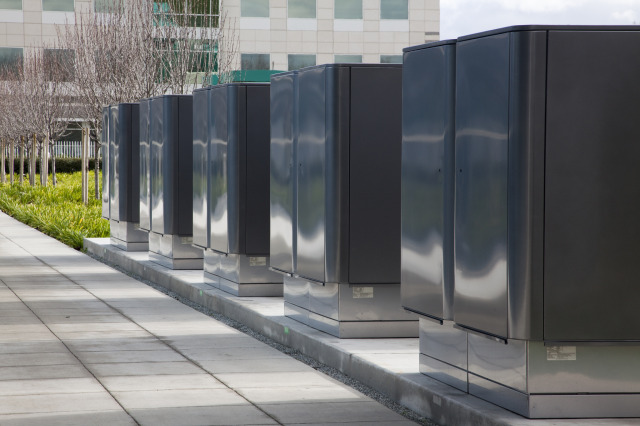How Does the Bloom Box Energy Server Work?

The Bloom Energy Server is made out of fuel cells, or electrochemical cells. A single fuel cell consists of an anode, a cathode, and an electrolyte stuck between the two. As fuel flows in through the anode side and an oxidant comes in over the cathode, a reaction is triggered that causes electrons to move into the fuel cell's circuit, producing electricity.
- The Bloom Energy Server isn't actually a server. In actuality, it's a distributed power generator. Each "server" produces 100 kW of power, consists of thousands of fuel cells, costs between $700,000 and $800,000, and pays for itself in three to 5 years based on an energy cost of 8 to 9 cents per kW hour.
- There are many different types of fuel cells. Some of the more popular ones include methanol fuel cells, hydrogen fuel cells, and zinc-air batteries. The Bloom Energy Server consists of solid oxide fuel cells, which are attractive because they can be made out of low-cost materials with high energy efficiencies.
- The cells can run on a variety of fuels, including traditional fuel, natural gas, biomass gas, landfill gas, and ethanol.
- Until now, technical challenges have stopped solid oxide fuel cells from being commercialized, but the company's cells ("sand" baked into ceramic squares that are coated with green and black inks) supposedly have overcome most of the issues. Bloom's Web site has a great animation showing how solid oxide fuel cells work.

- One of the biggest problems with solid oxide fuel cells is their temperature requirement--the ceramic squares only become active at extremely high temperatures (up to 1800 F). That means Bloom's cells will have to prove that they can remain durable under the stress--already, the company has had to come out to replace cells at eBay's installation, which has been running for just 7 months. In general, Bloom expects that its fuel cell stacks will have to be switched out twice during the device's 10 year lifespan.
- Bloom's device generates electricity at 50% to 55% conversion efficiency. In comparison, solar generally produces power at between 10% to 15% efficiency. But unlike solar panels, the Bloom Energy Server produces CO2 as a byproduct. According to the Energy Collective, "CO2 emissions when running on natural gas would be just under 0.8 pounds/kWh, which compares favorably to electricity from central station coal-fired plants (2 lbs/kWh) or natural gas plants (roughly 1.3 lbs/kWh) and the national average for on-grid electricity (around 1.3-1.5 lbs/kWh)." If the box runs on landfill gas or biogas, it produces net zero carbon emissions.
- Eventually, Bloom hopes that a scaled-down version device can be used in homes. A residential Bloom Box would produce 1 kW of power and cost approximately $3,000. But that probably won't happen for at least 10 years.
Some websites to read further:
- http://theweek.com/article/index/200144/What_is_the_Bloom_Box_anyway
- http://gm-volt.com/2010/02/28/the-bloom-box/

Thats awesome stuff. We should think about something like this for providing power to our campus. Research should also be focused in this direction.
ReplyDelete